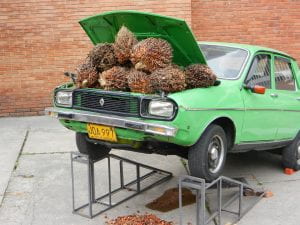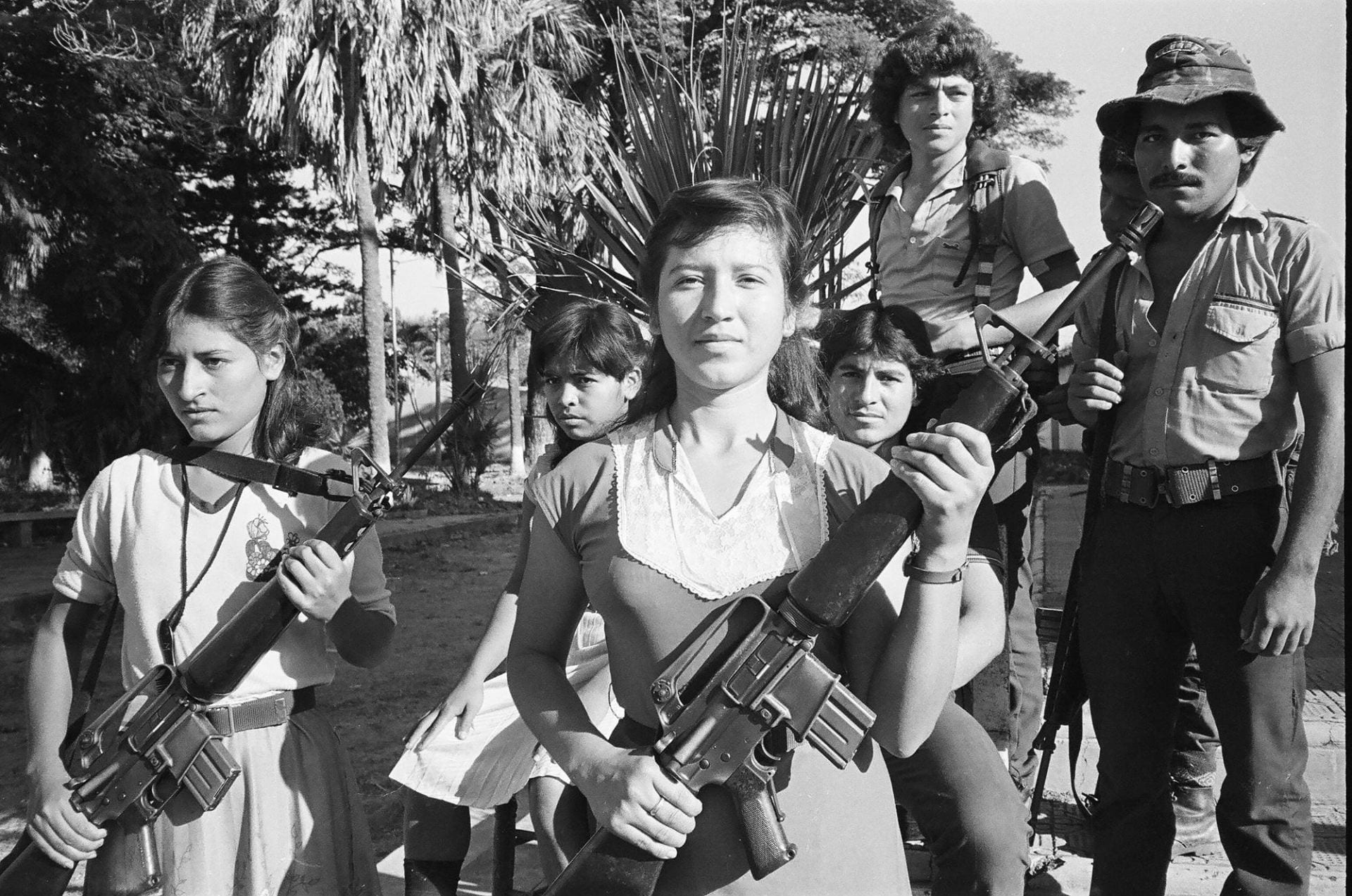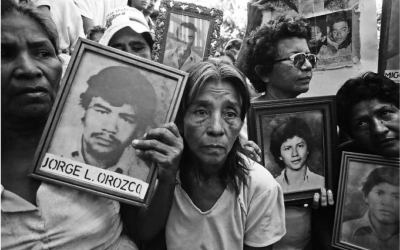
Renault 12 is part of an art exhibit Somos Tierra, developed as a result of a group dialogue in a series of workshops. Photo by J. Luke Pizzato
A green midsized Renault sedan sits on a ramp lifting the car´s open hood and revealing an engine stuffed with palm seeds. Entitled Renault 12, the piece is part of an exhibit Somos Tierra developed as a result of a large group dialogue. In a series of workshops that discussed the death of young taxi drivers, the arrival of the palm cultivation in the region, and massacres, the exhibit came into being as the brain child of Asociación Minga, a human rights organization that has turned to art to preserve and transmit victims’ stories.
Minga co-founder and artistic director Francisco Bustamante described how the image of the car emerged after “smaller group sessions developed a series of ideas, histories, memories, stories and drawings.” Ultimately, the group decided the image of the car would be an apt representation of the young taxi drivers they hoped to memorialize, many of whom had been killed as they were forced to transport paramilitaries and guerillas after the palm oil industry entered the region and exacerbated the violence there.
The scope of the problem in Colombia is enormous. According to statistics collected by the Colombian newsmagazine Semana, 5,405,629 Colombians have been direct victims of the Colombia armed conflict since 1985 (Semana, June 10, 2013). Think about it: nearly five and a half million have suffered torture, sexual assault, homicide, forced displacement, and injury from shrapnel and crossfire. Driven by this impossible reality various recent national and local governmental initiatives have sought formal reparations for this incredible number of victims. These include Law 1448 of 2011, popularly known as the Law of Victims, which has energized a process that intends to “establish judicial measures, administrative, social, economic, individual and collective for the benefit of victims that they might enjoy their right to truth, justice and reparations” (Ley de Víctimas y Restitución de Tierras, June, 2011). Pivotal within the social aspect of this project has been the development of a public history of the conflict, specifically the memorialization of these victims’ recent experiences.
Minga emerged in response to the “necessity to protect and accompany communities from far away territories forgotten by the state that had begun to suffer the impacts of the conflict in a very significant way.” The political reality of memory, therefore, has provided profoundly important work for human rights organizations like La Asociación Minga as they fight to ensure that the victims’ authentic accounts are communicated.
Although the Law of Victims explicitly states that memory should be allowed to develop openly without the bias of an official State Memory, Article 143 “On the Duty of State Memory” seeks the ideal of a free economy of memory wherein “society, through its different expressions such as those of victims… just as those of state organizations, can give account with competency, autonomy and resources” (Ley de Víctimas y Restitución de Tierras, June, 2011). Such an inclusive ideal, however, has proven problematic. Elizabeth Jelin, a Spanish academic in memory studies, asserts that though memory is necessarily public and social, public memory is never “collective memory.” It is rather, “shared memory, superimposed, the product of multiple interactions, framings in social contexts and in relations of power” (Los Trabajos de la Memoria, 2001).
Public memory is only ever developed within a contest of interacting perspectives, all with various arsenals of power and therefore varying degrees of agency in the debate. An excellent example of this dynamic is found in the Colombian false positives scandal of the past 10 years in which politically uninvolved civilians were killed by the Colombian Army and “subsequently presented as guerrilla casualties to inflate the combat ‘body count’” in the war against the FARC and other guerilla groups (The US National Security Archive, www.gwu.edu, January 2009). Mothers of victims have had to fight the state, not only in a legal battle over their loved ones’ remains, but also as part of semantic contest over the memory of a victim. Their perspectives have only recently developed a forceful voice.
Minga has dedicated the past 20 years to the task of effectively and authentically communicating the perspectives of the victims themselves. Originally a group of artists, activists, psychologists and sociologists working on a volunteer basis with victimized communities in Catatumbo, Asociación Minga, by 1990, was formally registered as a human rights protection organization, offering primarily pro bono legal assessments, casework and representation, and long-term community involvement. As Minga continued to grow, it began to parallel its traditional human rights advocacy with a series of art projects dedicated to enhancing the public visibility of the communities with which it had worked. Given a public that director Bustamante says was “indifferent, asleep, anesthetized”, he says they were “left with no alternative but to evidence their reality, to make it known, to bring it to light for the public.” Art had become a necessary tool in this mission.
Minga is most recognized for a series of projects they’ve called “Galleries of Memory.” Beginning with a project that emerged from work with war-torn communities in Putumayo and San Onofre, a traveling exhibition called Nunca Más toured libraries in Bogotá from 1994 to 1996. The tour was realized in collaboration with a long time partner organization, the Manuel Cepeda Foundation. Nunca Más was followed by another collaborative project at the end of the decade which they called the Buceo de la Memoria. This project brought various art exhibits to sites around Bogotá, public squares, schools and the national university. When members of the Manuel Cepeda Foundation received a series of threats that forced them to leave the country, they continued to put their exhibition on tour in France and Switzerland. When Minga and the Manuel Cepeda Foundation were reunited in Colombia in 2004, they developed a new exhibition with these same communities that they named Recuérdame, which toured the United States. With Recuérdame’s success, they were then able to develop a fourth gallery of memory, an exhibition they named Somos Tierra, this time informed by work with communities in Catatumbo and Montes de Maria, which is currently on tour in Bogotá.
According to Bustamante, these exhibitions have been the product of a common goal between Minga and the Manuel Cepeda Foundation to find “alternative languages that can generate more solidarity” between the victimized communities and the general public. As their galleries of memory present victims’ stories to audiences in Europe, the United States and in Colombia, Bustamante says that the role of his organization is only that of an intermediary. This passive attitude in project development is a critical element of Minga’s work, as all of their projects seeks to function through what Bustamante calls “horizontal dialogue.” He says Minga isn’t interested in their artists working as the “enlightened minds” who consult the community but then design projects independently. Minga is dedicated, rather, to the inclusive development of the artwork. “In a collective dialogue with the affected individuals, they tell their stories and we ask questions,” and on the basis of images and symbols that emerge from conversation, plans for the pieces take shape.
This unique artistic methodology has been in part affected by Minga’s use of a similar research paradigm in their more classical human rights work. In various projects wherein Minga has sought to develop local infrastructure for victimized communities, they have applied Orlando Fals Borda’s Participatory Action Research (PAR) method which seeks to empower communities to act for self-improvement by teaching systematic research methods that allow locals to lead data collection projects themselves and formally discuss their communities’ development interests. Minga led a project under this methodology with a group of women in Cauca to discuss food distribution and health care provision along with a contracted researcher. Bustamante says these women were able to use their “conclusions to discuss their case with authorities, and they could then begin to make their own proposals that agreed with their reality.” In parallel with PAR, Minga’s art-making process makes sure that communities with which they work are directly involved in the formation of the reality presented.
With projects like Somos Tierra, Bustamante says that Minga hopes to foster a greater sensibility for dialogue that might “permit an understanding, a comprehensions that would translate, in the future, to the reconciliation of our country.” It’s for this reason, Bustamante continues, that they use “a language of symbols and images. Because we believe symbols and images are less biased that words.” The goal would seem to be a language of memory that escapes the power play of political discourse and merely delivers the reality of the victim’s experience as explicitly and authentically as possible. Although the complex network of superimpositions present in any system of public memory make such a goal hugely difficult, Minga’s dedication to the support of the victim’s self-representation is an earnest attempt to achieve such an ideal.
Related Articles
A Search for Justice
In 2004, when I left Harvard and last saw you, I thought I would never learn the truth of what exactly happened to Carlos Horacio in the horrendous holocaust of the Palace of Justice in Bogotá. Yet fate was holding a tremendous surprise for my daughters and me, filled with…
Memory: Editor’s Letter
Editor's Letter Memory Irma Flaquer’s image as a 22-year-old Guatemalan reporter stares from the pages of a 1960 Time magazine, her eyes blackened by a government mob that didn’t like her feisty stance. She never gave up, fighting with her pen against the long...
A Search for Justice in El Salvador: One Legacy of Ignacio Martín-Baró
In the small rural town of Arcatao, Chalatenango, Rosa Rivera clung to the hope that one day she would find the remains of her disappeared mother and father and lay them to rest in peace. Others sought to exhume mass graves hoping to recover bodies of nearly 1,000 relatives massacred in the Río Sumpul. …




